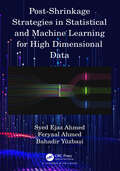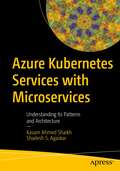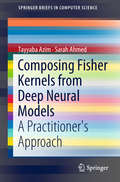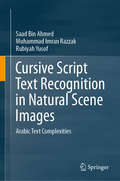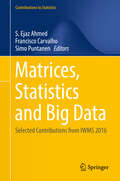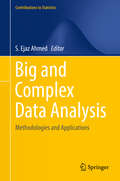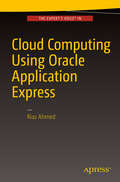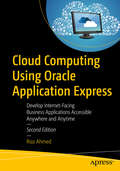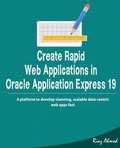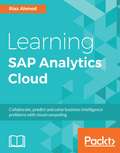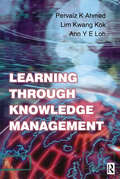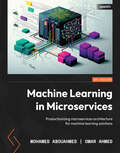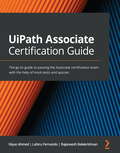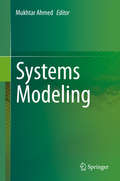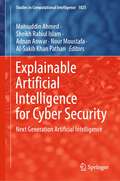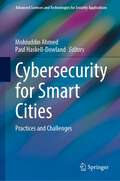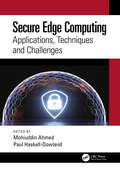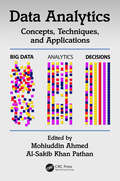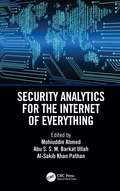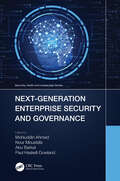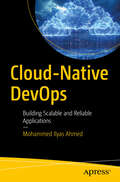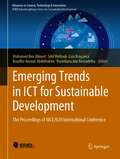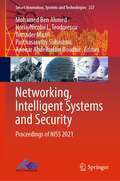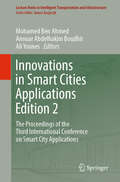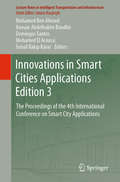- Table View
- List View
Post-Shrinkage Strategies in Statistical and Machine Learning for High Dimensional Data
by Syed Ejaz Ahmed Feryaal Ahmed Bahadir YüzbaşıThis book presents some post-estimation and predictions strategies for the host of useful statistical models with applications in data science. It combines statistical learning and machine learning techniques in a unique and optimal way. It is well-known that machine learning methods are subject to many issues relating to bias, and consequently the mean squared error and prediction error may explode. For this reason, we suggest shrinkage strategies to control the bias by combining a submodel selected by a penalized method with a model with many features. Further, the suggested shrinkage methodology can be successfully implemented for high dimensional data analysis. Many researchers in statistics and medical sciences work with big data. They need to analyse this data through statistical modelling. Estimating the model parameters accurately is an important part of the data analysis. This book may be a repository for developing improve estimation strategies for statisticians. This book will help researchers and practitioners for their teaching and advanced research, and is an excellent textbook for advanced undergraduate and graduate courses involving shrinkage, statistical, and machine learning. The book succinctly reveals the bias inherited in machine learning method and successfully provides tools, tricks and tips to deal with the bias issue. Expertly sheds light on the fundamental reasoning for model selection and post estimation using shrinkage and related strategies. This presentation is fundamental, because shrinkage and other methods appropriate for model selection and estimation problems and there is a growing interest in this area to fill the gap between competitive strategies. Application of these strategies to real life data set from many walks of life. Analytical results are fully corroborated by numerical work and numerous worked examples are included in each chapter with numerous graphs for data visualization. The presentation and style of the book clearly makes it accessible to a broad audience. It offers rich, concise expositions of each strategy and clearly describes how to use each estimation strategy for the problem at hand. This book emphasizes that statistics/statisticians can play a dominant role in solving Big Data problems, and will put them on the precipice of scientific discovery. The book contributes novel methodologies for HDDA and will open a door for continued research in this hot area. The practical impact of the proposed work stems from wide applications. The developed computational packages will aid in analyzing a broad range of applications in many walks of life.
Azure Kubernetes Services with Microservices: Understanding Its Patterns and Architecture
by Kasam Ahmed Shaikh Shailesh S. AgaskarDesign and implement scalable microservices using Azure Kubernetes Services (AKS) and other Azure Services. This book will help you understand why and when to choose microservices as a solution for modernization and how to use Azure DevOps to implement CI/CD for deploying microservices. The book starts with an introduction to the evolution to microservices and AKS along with its components. You will learn design patterns to implement microservices on AKS and understand Kubernetes as a container orchestration platform. You will go through the common errors faced in AKS-based applications and ways to handle them. You will learn error handling tips and tricks and how to design for business continuity and disaster recovery. The book discusses things you should know related to security and monitoring when working with AKS-based applications. The book presents a practical approach to set up processes for CI/CD, such as building Build and release pipelines for AKS deployment using Azure DevOps. After reading this book, you will understand design considerations for designing scalable microservices and know how to implement the design through AKS. What You Will LearnKnow design patterns for microservices and how to handle failure scenariosBe aware of architecture and design considerationsUnderstand container and Kubernetes architecture componentsUnderstand security and monitoring aspectsTake a practical approach to continuous integration and continuous deliveryWho This Book Is ForIT professionals associated with cloud computing, especially with Microsoft Azure
Composing Fisher Kernels from Deep Neural Models: A Practitioner's Approach (SpringerBriefs in Computer Science)
by Sarah Ahmed Tayyaba AzimThis book shows machine learning enthusiasts and practitioners how to get the best of both worlds by deriving Fisher kernels from deep learning models. In addition, the book shares insight on how to store and retrieve large-dimensional Fisher vectors using feature selection and compression techniques. Feature selection and feature compression are two of the most popular off-the-shelf methods for reducing data’s high-dimensional memory footprint and thus making it suitable for large-scale visual retrieval and classification. Kernel methods long remained the de facto standard for solving large-scale object classification tasks using low-level features, until the revival of deep models in 2006. Later, they made a comeback with improved Fisher vectors in 2010. However, their supremacy was always challenged by various versions of deep models, now considered to be the state of the art for solving various machine learning and computer vision tasks. Although the two research paradigms differ significantly, the excellent performance of Fisher kernels on the Image Net large-scale object classification dataset has caught the attention of numerous kernel practitioners, and many have drawn parallels between the two frameworks for improving the empirical performance on benchmark classification tasks. Exploring concrete examples on different data sets, the book compares the computational and statistical aspects of different dimensionality reduction approaches and identifies metrics to show which approach is superior to the other for Fisher vector encodings. It also provides references to some of the most useful resources that could provide practitioners and machine learning enthusiasts a quick start for learning and implementing a variety of deep learning models and kernel functions.
Cursive Script Text Recognition in Natural Scene Images: Arabic Text Complexities
by Saad Bin Ahmed Muhammad Imran Razzak Rubiyah YusofThis book offers a broad and structured overview of the state-of-the-art methods that could be applied for context-dependent languages like Arabic. It also provides guidelines on how to deal with Arabic scene data that appeared in an uncontrolled environment impacted by different font size, font styles, image resolution, and opacity of text. Being an intrinsic script, Arabic and Arabic-like languages attract attention from research community. There are a number of challenges associated with the detection and recognition of Arabic text from natural images. This book discusses these challenges and open problems and also provides insights into the complexities and issues that researchers encounter in the context of Arabic or Arabic-like text recognition in natural and document images. It sheds light on fundamental questions, such as a) How the complexity of Arabic as a cursive scripts can be demonstrated b) What the structure of Arabic text is and how to consider the features from a given text and c) What guidelines should be followed to address the context learning ability of classifiers existing in machine learning.
Matrices, Statistics and Big Data: Selected Contributions from IWMS 2016 (Contributions to Statistics)
by S. Ejaz Ahmed Francisco Carvalho Simo PuntanenThis volume features selected, refereed papers on various aspects of statistics, matrix theory and its applications to statistics, as well as related numerical linear algebra topics and numerical solution methods, which are relevant for problems arising in statistics and in big data. The contributions were originally presented at the 25th International Workshop on Matrices and Statistics (IWMS 2016), held in Funchal (Madeira), Portugal on June 6-9, 2016. The IWMS workshop series brings together statisticians, computer scientists, data scientists and mathematicians, helping them better understand each other’s tools, and fostering new collaborations at the interface of matrix theory and statistics.
Big and Complex Data Analysis: Methodologies and Applications (Contributions to Statistics)
by S. Ejaz AhmedThis volume conveys some of the surprises, puzzles and success stories in high-dimensional and complex data analysis and related fields. Its peer-reviewed contributions showcase recent advances in variable selection, estimation and prediction strategies for a host of useful models, as well as essential new developments in the field. The continued and rapid advancement of modern technology now allows scientists to collect data of increasingly unprecedented size and complexity. Examples include epigenomic data, genomic data, proteomic data, high-resolution image data, high-frequency financial data, functional and longitudinal data, and network data. Simultaneous variable selection and estimation is one of the key statistical problems involved in analyzing such big and complex data. The purpose of this book is to stimulate research and foster interaction between researchers in the area of high-dimensional data analysis. More concretely, its goals are to: 1) highlight and expand the breadth of existing methods in big data and high-dimensional data analysis and their potential for the advancement of both the mathematical and statistical sciences; 2) identify important directions for future research in the theory of regularization methods, in algorithmic development, and in methodologies for different application areas; and 3) facilitate collaboration between theoretical and subject-specific researchers.
Cloud Computing Using Oracle Application Express
by Riaz AhmedDevelop cloud-based applications rapidly using the Oracle Application Express (APEX) platform. You will learn to develop a comprehensive functional business application which can be deployed in your organization. Cloud Computing Using Oracle Application Express will teach you how to develop a complete general ledger accounting system which will be accessible through a variety of devices, including desktops, laptops, and the latest smartphones. What You Will Learn: Use new Oracle APEX 5. 0 techniques Develop a complete general ledger accounting system named The Cloud Accountant Develop cloud-based business apps accessible anywhere and anytime Enhance your APEX development skills Who This Book Is For: Web developers who possess some working knowledge of Oracle Application Express, and developers who have been using Oracle Forms and now wish to use their existing SQL and PL/SQL expertise.
Cloud Computing Using Oracle Application Express: Develop Internet-Facing Business Applications Accessible Anywhere and Anytime
by Riaz AhmedGet the domain knowledge you need to develop real-world business apps for and in the cloud. You’ll see how Oracle APEX has made the life of web developers much easier and how it helps you create web-based data-centric applications easily and instantly without writing screeds of code.In Cloud Computing Using Oracle Application Express, you will develop a complete general ledger accounting system named the Cloud Accountant which will be accessible through a variety of devices including desktops, laptops, and the latest smartphones. This new edition also incorporates the new application page creation process, which differs from the previous version. You’ll cover other new areas, such as the updated UI elements and properties, and the interactive grid. Besides the development of a full application that you can deploy in your organization, the book teaches many new techniques to further enhance your APEX development skills.What You Will LearnDiscover new development techniques for APEX developersDevelop cloud-based ERP applicationsBuild a cloud-based application on Oracle APEXIntegrate the free JasperReports server and report designing tool with Oracle APEXWho This Book Is ForWeb developers who possess some working knowledge of Oracle Application Express, and developers who have been using Oracle Forms and now wish to use their existing SQL and PL/SQL expertise.
Create Rapid Web Applications in Oracle Application Express 19: A platform to develop stunning, scalable data-centric web apps fast
by Riaz AhmedThis book introduces you to the art of building web applications by iteratively developing the sample database application (provided with Oracle APEX) from scratch. The application demonstrates how to display summary information, use reports and forms for viewing, updating, and adding information, include charts and maps to visualize information, and create dedicated mobile pages. Oracle APEX is an amazing development platform in which you can build robust web applications. Not only it provides an environment where you can rapidly develop data-centric web applications, it also allows end-users to interact with their data via tools like interactive report, interactive grid, different types of charts, maps and more. This book helps absolute beginners who wish to learn from self-paced professional guidance and need a solid foundation in Oracle APEX.
Learning SAP Analytics Cloud
by Riaz AhmedStart making better business decisions backed by data About This Book • Predict new opportunities and risks in a few mouse clicks • Eliminate complexity with tools that let you plan, analyze, and collaborate in context—in real time • Discover, visualize, plan, and predict in a single product with agile BI tools Who This Book Is For This book targets IT professionals, business analysts, BI developers, managers, newcomers to SAP Analytics Cloud, and ultimately anyone who wants to learn from self-paced, professional guidance and needs a solid foundation in SAP Analytics Cloud. What You Will Learn • A clear understanding of SAP Analytics Cloud platform • Create data models using different data sources, including Excel and text files . • Present professional analyses using different types of charts, tables, geo maps, and more • Using stories, drill up and down instantly to analyze data from various angles • Share completed stories with other team members or compile them in SAP Digital Boardroom agendas for presentation to major stakeholders • Export the results of a story to a PDF file • Save time by planning, analyzing, predicting, and collaborating in context • Discover, visualize, plan, and predict in one product as opposed to separate solutions In Detail The book starts with the basics of SAP Analytics Cloud (formerly known as SAP BusinessObjects Cloud) and exposes almost every significant feature a beginner needs to master. Packed with illustrations and short, essential, to-the-point descriptions, the book provides a unique learning experience. Your journey of exploration starts with a basic introduction to the SAP Analytics Cloud platform. You will then learn about different segments of the product, such as Models, Stories, Digital Boardroom, and so on. Then, you are introduced to the product's interface: the Home screen, the main menu, and more. Then comes the hands-on aspect of the book, which starts with model creation. Next, you learn how to utilize a model to prepare different types of stories(reports) with the help of charts, tables, Geo Maps, and more. In the final chapters of this book, you will learn about Digital Boardroom, Collaboration, and Administration. Style and approach The easy-to-follow visual instructions provided in this book help business users and report developers create simple and complex stories (reports) quickly
Learning Through Knowledge Management
by Pervaiz K. Ahmed Kwang Kok Lim Ann Y Loh'Learning through Knowledge Management' provides an insightful overview of the main issues integrating learning and Knowledge Management. It offers a rich resource of case examples that highlight Knowledge Management in practice. The text explores and defines learning and Knowledge Management concepts, and deals with the elements that play an important part in determining implementation success in the organization. The chapters present a managerially oriented discussion of the following key areas:* The role of processes in managing knowledge* The behavioural side of Knowledge Management * Leadership reflexes for knowledge management success* The key features of Information Technology required for Knowledge Management* The future of Knowledge Management as part of organization management.There are many case studies which include: British Airways BP Amoco Ford Hewlett Packard Xerox Swedish Police IBM The case studies encompass a diverse and broad range of sectors, maturity of practice, problems and approaches to Knowledge Management.
Machine Learning in Microservices: Productionizing microservices architecture for machine learning solutions
by Omar Ahmed Mohamed AbouahmedImplement real-world machine learning in a microservices architecture as well as design, build, and deploy intelligent microservices systems using examples and case studiesPurchase of the print or Kindle book includes a free PDF eBookKey FeaturesDesign, build, and run microservices systems that utilize the full potential of machine learningDiscover the latest models and techniques for combining microservices and machine learning to create scalable systemsImplement machine learning in microservices architecture using open source applications with pros and consBook DescriptionWith the rising need for agile development and very short time-to-market system deployments, incorporating machine learning algorithms into decoupled fine-grained microservices systems provides the perfect technology mix for modern systems. Machine Learning in Microservices is your essential guide to staying ahead of the curve in this ever-evolving world of technology.The book starts by introducing you to the concept of machine learning microservices architecture (MSA) and comparing MSA with service-based and event-driven architectures, along with how to transition into MSA. Next, you'll learn about the different approaches to building MSA and find out how to overcome common practical challenges faced in MSA design. As you advance, you'll get to grips with machine learning (ML) concepts and see how they can help better design and run MSA systems. Finally, the book will take you through practical examples and open source applications that will help you build and run highly efficient, agile microservices systems.By the end of this microservices book, you'll have a clear idea of different models of microservices architecture and machine learning and be able to combine both technologies to deliver a flexible and highly scalable enterprise system.What you will learnRecognize the importance of MSA and ML and deploy both technologies in enterprise systemsExplore MSA enterprise systems and their general practical challengesDiscover how to design and develop microservices architectureUnderstand the different AI algorithms, types, and models and how they can be applied to MSAIdentify and overcome common MSA deployment challenges using AI and ML algorithmsExplore general open source and commercial tools commonly used in MSA enterprise systemsWho this book is forThis book is for machine learning solution architects, system and machine learning developers, and system and solution integrators of private and public sector organizations. Basic knowledge of DevOps, system architecture, and artificial intelligence (AI) systems is assumed, and working knowledge of the Python programming language is highly desired.
UiPath Associate Certification Guide: The go-to guide to passing the Associate certification exam with the help of mock tests and quizzes
by Niyaz Ahmed Lahiru Fernando Rajaneesh BalakrishnanA practical syllabus-based UiPath Associate certification guide to confidently passing your UiPath RPA Associate certification examination, covering real-world business cases, mock tests, and moreKey FeaturesGet certified successfully with this detailed syllabus-oriented examination guideWork with real-world business cases that will help you grasp RPA topics better using practical examplesPractice with quizzes and mock exam papers with answers to prepare for the exam confidentlyBook DescriptionUiPath is the most popular vendor in the Robotic Process Automation (RPA) industry. If you're an RPA enthusiast or citizen developer who wants to succeed in the industry, achieving this certification can help you get accredited and ready for real-world challenges using UiPath.UiPath Associate Certification Guide offers complete, up-to-date coverage of the UiPath RPA Associate certification exam to help you pass on the first attempt and get certified. The book is written in a clear, succinct way with self-assessment questions, quizzes with answers at the end of each chapter, exam tips, and mock exams with detailed answers and explanations. You'll start by getting to grips with the basic concepts of UiPath RPA, and then progress to an in-depth discussion of all the concepts required for Associate certification. Finally, you'll develop UiPath skills by gaining the required knowledge and implement these skills using sample business cases.By the end of this UiPath book, you'll have covered everything you need to pass the exam, gained the knowledge you need to work on real-world case studies, and learned how to apply the various concepts to build enterprise-level use cases.What you will learnGet to grips with the basic concepts of UiPath RPAEquip yourself with every resource required to pass the Associate exam on the first attemptGain the ability to apply what you've learned using real-world use casesWork on different use cases and test your knowledge by taking quizzesGet a feel for the real exam with practice questions and mock examsUnderstand the concepts used in building enterprise-level use casesWho this book is forThis RPA book is for those in technical and semi-technical roles such as citizen RPA developers, junior RPA developers, RPA developers, solution architects, business analysts, system administrators, college or university students and graduates, and UiPath and partner employees in pre-sales, services, support, and so on. If you are looking to get certified and meet the industry standard with the largest RPA vendor, then this book is for you.
Systems Modeling
by Mukhtar AhmedAchieving food security and economic developmental objectives in the face of climate change and rapid population growth requires systems modelling approaches, for example in the design of sustainable agriculture farming systems. Such approaches increase our understanding of system responses to different soil and climatic conditions, and provide insights into the effects of various variable climate change scenarios, providing valuable information for decision-makers. Further, in the agricultural sector, systems modelling can help optimise crop management and adaptation measures to boost productivity under variable climatic conditions. Presenting key outcomes from crop models used in agricultural systems this book is a valuable resource for professionals interested in using modelling approaches to manage the growth and improve the quality of various crops.
Explainable Artificial Intelligence for Cyber Security: Next Generation Artificial Intelligence (Studies in Computational Intelligence #1025)
by Mohiuddin Ahmed Sheikh Rabiul Islam Adnan Anwar Nour Moustafa Al-Sakib Khan PathanThis book presents that explainable artificial intelligence (XAI) is going to replace the traditional artificial, machine learning, deep learning algorithms which work as a black box as of today. To understand the algorithms better and interpret the complex networks of these algorithms, XAI plays a vital role. In last few decades, we have embraced AI in our daily life to solve a plethora of problems, one of the notable problems is cyber security. In coming years, the traditional AI algorithms are not able to address the zero-day cyber attacks, and hence, to capitalize on the AI algorithms, it is absolutely important to focus more on XAI. Hence, this book serves as an excellent reference for those who are working in cyber security and artificial intelligence.
Cybersecurity for Smart Cities: Practices and Challenges (Advanced Sciences and Technologies for Security Applications)
by Mohiuddin Ahmed Paul Haskell-DowlandEnsuring cybersecurity for smart cities is crucial for a sustainable cyber ecosystem. Given the undeniable complexity of smart cities, fundamental issues such as device configurations and software updates should be addressed when it is most needed to fight cyber-crime and ensure data privacy. This book addresses the cybersecurity challenges associated with smart cities, aiming to provide a bigger picture of the concepts, intelligent techniques, practices and research directions in this area. Furthermore, this book serves as a single source of reference for acquiring knowledge on the technology, processes and people involved in the next-generation of cyber-smart cities.
Secure Edge Computing: Applications, Techniques and Challenges
by Mohiuddin Ahmed Paul Haskell-DowlandThe internet is making our daily life as digital as possible and this new era is called the Internet of Everything (IoE). Edge computing is an emerging data analytics concept that addresses the challenges associated with IoE. More specifically, edge computing facilitates data analysis at the edge of the network instead of interacting with cloud-based servers. Therefore, more and more devices need to be added in remote locations without any substantial monitoring strategy. This increased connectivity and the devices used for edge computing will create more room for cyber criminals to exploit the system’s vulnerabilities. Ensuring cyber security at the edge should not be an afterthought or a huge challenge. The devices used for edge computing are not designed with traditional IT hardware protocols. There are diverse-use cases in the context of edge computing and Internet of Things (IoT) in remote locations. However, the cyber security configuration and software updates are often overlooked when they are most needed to fight cyber crime and ensure data privacy. Therefore, the threat landscape in the context of edge computing becomes wider and far more challenging. There is a clear need for collaborative work throughout the entire value chain of the network. In this context, this book addresses the cyber security challenges associated with edge computing, which provides a bigger picture of the concepts, techniques, applications, and open research directions in this area. In addition, the book serves as a single source of reference for acquiring the knowledge on the technology, process and people involved in next generation computing and security. It will be a valuable aid for researchers, higher level students and professionals working in the area.
Data Analytics: Concepts, Techniques, and Applications
by Mohiuddin Ahmed Al-Sakib Khan PathanLarge data sets arriving at every increasing speeds require a new set of efficient data analysis techniques. Data analytics are becoming an essential component for every organization and technologies such as health care, financial trading, Internet of Things, Smart Cities or Cyber Physical Systems. However, these diverse application domains give rise to new research challenges. In this context, the book provides a broad picture on the concepts, techniques, applications, and open research directions in this area. In addition, it serves as a single source of reference for acquiring the knowledge on emerging Big Data Analytics technologies.
Security Analytics for the Internet of Everything
by Mohiuddin Ahmed Abu S. S. M. Barkat Ullah Al-Sakib Khan PathanSecurity Analytics for the Internet of Everything compiles the latest trends, technologies, and applications in this emerging field. It includes chapters covering emerging security trends, cyber governance, artificial intelligence in cybersecurity, and cyber challenges. Contributions from leading international experts are included. The target audience for the book is graduate students, professionals, and researchers working in the fields of cybersecurity, computer networks, communications, and the Internet of Everything (IoE). The book also includes some chapters written in a tutorial style so that general readers can easily grasp some of the ideas.
Next-Generation Enterprise Security and Governance (Security, Audit and Leadership Series)
by Mohiuddin AhmedThe Internet is making our daily lives as digital as possible, and this new era is called the Internet of Everything (IoE). The key force behind the rapid growth of the Internet is the technological advancement of enterprises. The digital world we live in is facilitated by these enterprises’ advances and business intelligence. These enterprises need to deal with gazillions of bytes of data, and in today’s age of General Data Protection Regulation, enterprises are required to ensure privacy and security of large-scale data collections. However, the increased connectivity and devices used to facilitate IoE are continually creating more room for cybercriminals to find vulnerabilities in enterprise systems and flaws in their corporate governance. Ensuring cybersecurity and corporate governance for enterprises should not be an afterthought or present a huge challenge. In recent times, the complex diversity of cyber-attacks has been skyrocketing, and zero-day attacks, such as ransomware, botnet, and telecommunication attacks, are happening more frequently than before. New hacking strategies would easily bypass existing enterprise security and governance platforms using advanced, persistent threats. For example, in 2020, the Toll Group firm was exploited by a new crypto-attack family for violating its data privacy, where an advanced ransomware technique was launched to exploit the corporation and request a huge figure of monetary ransom. Even after applying rational governance hygiene, cybersecurity configuration and software updates are often overlooked when they are most needed to fight cyber-crime and ensure data privacy. Therefore, the threat landscape in the context of enterprises has become wider and far more challenging. There is a clear need for collaborative work throughout the entire value chain of this network. In this context, this book addresses the cybersecurity and cooperate governance challenges associated with enterprises, which will provide a bigger picture of the concepts, intelligent techniques, practices, and open research directions in this area. This book serves as a single source of reference for acquiring the knowledge on the technology, process, and people involved in next-generation privacy and security.
Cloud-Native DevOps: Building Scalable and Reliable Applications
by Mohammed Ilyas AhmedThis book delivers cloud-based applications that are both scalable and reliable, aligning with the evolving needs of the present user base. This innovative approach blends the agility of cloud computing with the efficiency of contemporary DevOps methodologies. The book starts by providing valuable insights into the ever-evolving software landscape of Cloud-native DevOps. It delves into strategies for crafting scalable and dependable applications and illustrates the art of leveraging open-source tools to enhance collaboration. It navigates through the integral role of microservices in contemporary software development and imparts the know-how to integrate them with DevOps practices. The book simplifies container technology, with a focus on Docker and Kubernetes. It further elucidates the process of streamlining software delivery through Continuous Integration and Continuous Deployment (CI/CD). As you progress, you will explore open-source tools, including Argo, Kubeflow Pipelines, and AWS Step Functions. The concluding section covers real-world case studies and best practices for implementing Cloud-native DevOps. The book reviews the core concepts covered throughout and provides an exciting glimpse into the future of Cloud-native DevOps. Upon completing this book, you will be well-versed in the principles and practices of Cloud-native DevOps, understand real-world applications, and recognize the critical importance of security in cloud computing. What You Will Learn Create cloud-based applications that can scale with the changing needs of today's user base Combine the flexibility of cloud computing with the efficiency of modern DevOps methodologies Understand the core concepts and principles of Cloud-native DevOps Understand microservices, containers, and continuous integration and continuous deployment (CI/CD) Who This Book Is For DevOps engineers, cloud architects, software developers, system administrators, IT managers, team leads, and business decision makers
Emerging Trends in ICT for Sustainable Development: The Proceedings of NICE2020 International Conference (Advances in Science, Technology & Innovation)
by Mohamed Ben Ahmed Sehl Mellouli Luis Braganca Boudhir Anouar Abdelhakim Kwintiana Ane BernadettaThis book features original research and recent advances in ICT fields related to sustainable development. Based the International Conference on Networks, Intelligent systems, Computing & Environmental Informatics for Sustainable Development, held in Marrakech in April 2020, it features peer-reviewed chapters authored by prominent researchers from around the globe. As such it is an invaluable resource for courses in computer science, electrical engineering and urban sciences for sustainable development. This book covered topics including• Green Networks • Artificial Intelligence for Sustainability• Environment Informatics• Computing Technologies
Networking, Intelligent Systems and Security: Proceedings of NISS 2021 (Smart Innovation, Systems and Technologies #237)
by Mohamed Ben Ahmed Horia-Nicolai L. Teodorescu Tomader Mazri Parthasarathy Subashini Anouar Abdelhakim BoudhirThis book gathers best selected research papers presented at the International Conference on Networking, Intelligent Systems and Security, held in Kenitra, Morocco, during 01–02 April 2021. The book highlights latest research and findings in the field of ICT, and it provides new solutions, efficient tools, and techniques that draw on modern technologies to increase urban services. In addition, it provides a critical overview of the status quo, shares new propositions, and outlines future perspectives in networks, smart systems, security, information technologies, and computer science.
Innovations in Smart Cities Applications Edition 2: The Proceedings of the Third International Conference on Smart City Applications (Lecture Notes in Intelligent Transportation and Infrastructure)
by Mohamed Ben Ahmed Anouar Abdelhakim Boudhir Ali YounesThis book highlights cutting-edge research presented at the third installment of the International Conference on Smart City Applications (SCA2018), held in Tétouan, Morocco on October 10–11, 2018. It presents original research results, new ideas, and practical lessons learned that touch on all aspects of smart city applications. The respective papers share new and highly original results by leading experts on IoT, Big Data, and Cloud technologies, and address a broad range of key challenges in smart cities, including Smart Education and Intelligent Learning Systems, Smart Healthcare, Smart Building and Home Automation, Smart Environment and Smart Agriculture, Smart Economy and Digital Business, and Information Technologies and Computer Science, among others. In addition, various novel proposals regarding smart cities are discussed. Gathering peer-reviewed chapters written by prominent researchers from around the globe, the book offers an invaluable instructional and research tool for courses on computer and urban sciences; students and practitioners in computer science, information science, technology studies and urban management studies will find it particularly useful. Further, the book is an excellent reference guide for professionals and researchers working in mobility, education, governance, energy, the environment and computer sciences.
Innovations in Smart Cities Applications Edition 3: The Proceedings of the 4th International Conference on Smart City Applications (Lecture Notes in Intelligent Transportation and Infrastructure)
by Mohamed Ben Ahmed Anouar Abdelhakim Boudhir Domingos Santos Mohamed El Aroussi İsmail Rakıp KarasThis book highlights original research and recent advances in various fields related to smart cities and their applications. It gathers papers presented at the Fourth International Conference on Smart City Applications (SCA19), held on October 2–4, 2019, in Casablanca, Morocco. Bringing together contributions by prominent researchers from around the globe, the book offers an invaluable instructional and research tool for courses on computer science, electrical engineering, and urban sciences. It is also an excellent reference guide for professionals, researchers, and academics in the field of smart cities. This book covers topics including: • Smart Citizenship• Smart Education • Digital Business and Smart Governance • Smart Health Care • New Generation of Networks and Systems for Smart Cities • Smart Grids and Electrical Engineering • Smart Mobility • Smart Security • Sustainable Building • Sustainable Environment
